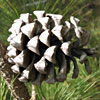Stone Pine is a large and magnificent coniferous evergreen tree. It reaches a height of up to 25 meters and tends to create a mushroom-shaped crown. It contains resin ducts in all of its tissues, which secrete and transport resin. The leaves are needle-shaped, rigid and thick, and are carried in groups of 2-3 at the head of dwarfed shoots. The leaves have a length of 10-20 cm, and persist for several years. The gray-red bark of the trunk and the mature branches is scaly and has deep cracks. The stone pines bloom in the spring, with tiny single-sex cones (strobili) that are carried in dense clusters at the tips of the branches. The flowers are pollinated by wind. The cones of male flowers and female flowers grow on the same individual. On the suitable day (the first warm and dry day in spring), the air becomes filled with clouds of pine pollen, which is dispersed from the male cones. One ten-year old branch produces 350,000,000 pollen grains. The pollen is carried by the wind and reaches female cones which are also found near the ends of the branches. The seeds mature only in the third year after pollination. The seeds develop within the female cone, whose scales open when the time comes to disperse the seeds. The seeds are edible and tasty, are sold and known as pine nuts or piñones.
The seed is enveloped by a stone-hard shell (which is why the name Stone Pine was suggested in Hebrew), and is why it is called the Stone Pine in English, i.e. a pine with a pit. The cone is spherical to ovate, 15 cm long, with crude scales.
The largest individual in Israel grows in the Bahai Garden in Acre. The species originates from southern Europe, from the north Mediterranean countries. It may have reached Israel for the first time during the Middle Ages. In spite of the size of many individuals, not many centuries-old trees are known in Israel. A very old tree was felled in the Armenian Quarter in Jerusalem in the 1990's and according to its ring count it was 210 years old. The Templars were the ones who renewed the planting of Pinus pinea in Israel during the 20th century. In Lebanon there are numerous plantations of this species on sandstone hills.
The genus Pinus presents an impressive variety of cone shapes, and the different species are recognized by the shape of their cone. Pines provide half of the global wood supply for building construction and for furniture.. The resin is also economical, and is used for production of glue and turpentine. Differences in the resin and its distribution within the wood tissue of different species are the main factors that determine the quality of the wood and its use. Economic use of pine in Israel is very limited: it is used for producing fiberboard and crates, as well as wood-coal.
Pines are very common in temperate and cool-temperate regions of the Northern Hemisphere. The genus contains 90 species. The pine’s family also includes the Cedar (Cedrus), which includes 3 species in the Old World, from the Atlas Mountains to the Himalaya Mountains. In English, other completely different conifers from other families are commonly called cedar.
The oldest trees in the world belong to an American group of pines, called Bristlecone Pines. They grow in the mountains of Western United States, and are slow growers, such that their extreme aged is not expressed in an impressive and wide trunk at all. One individual that grows in the White Mountains of northeast California has been named “Methuselah” and is considered the oldest living organism on earth. It is about 4,700 years old.
Written by Mike Livne






